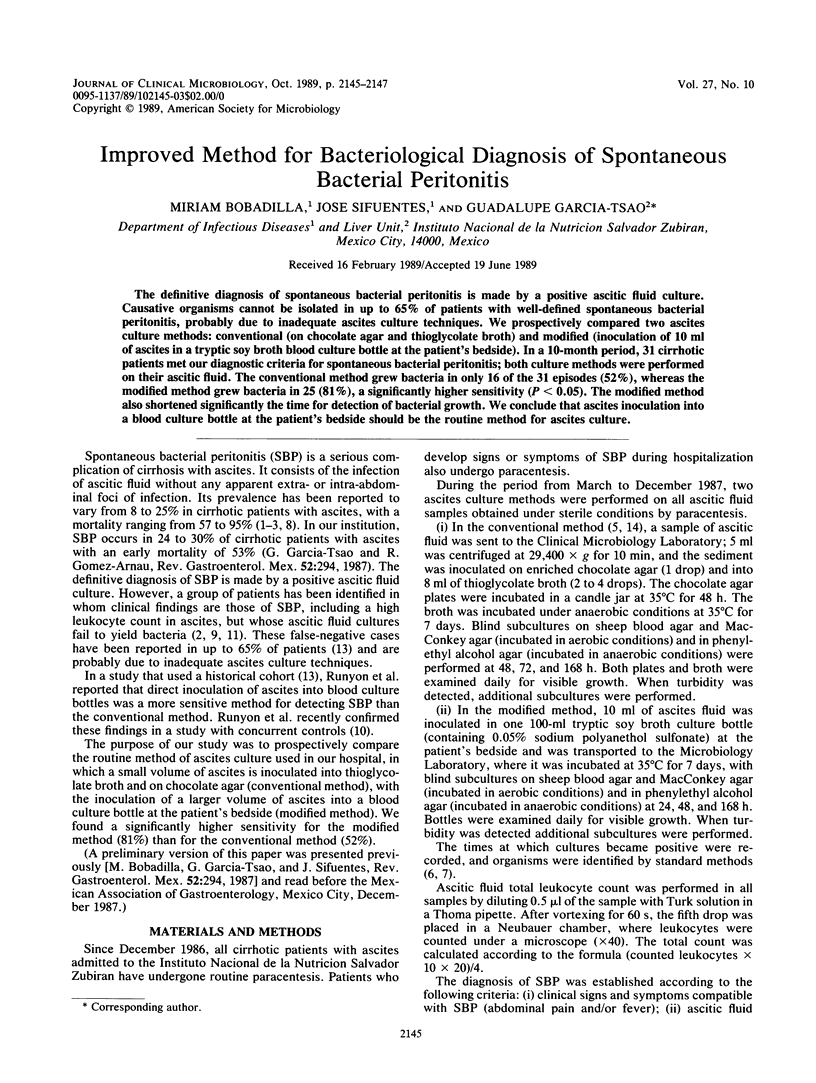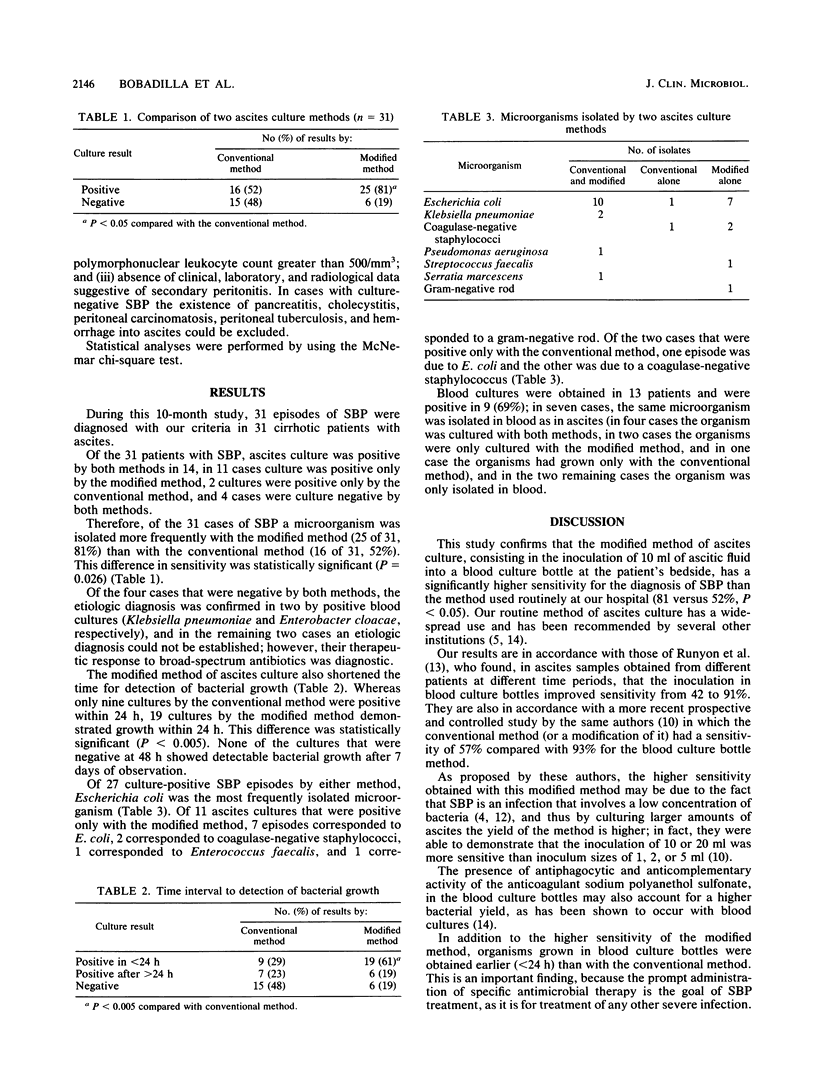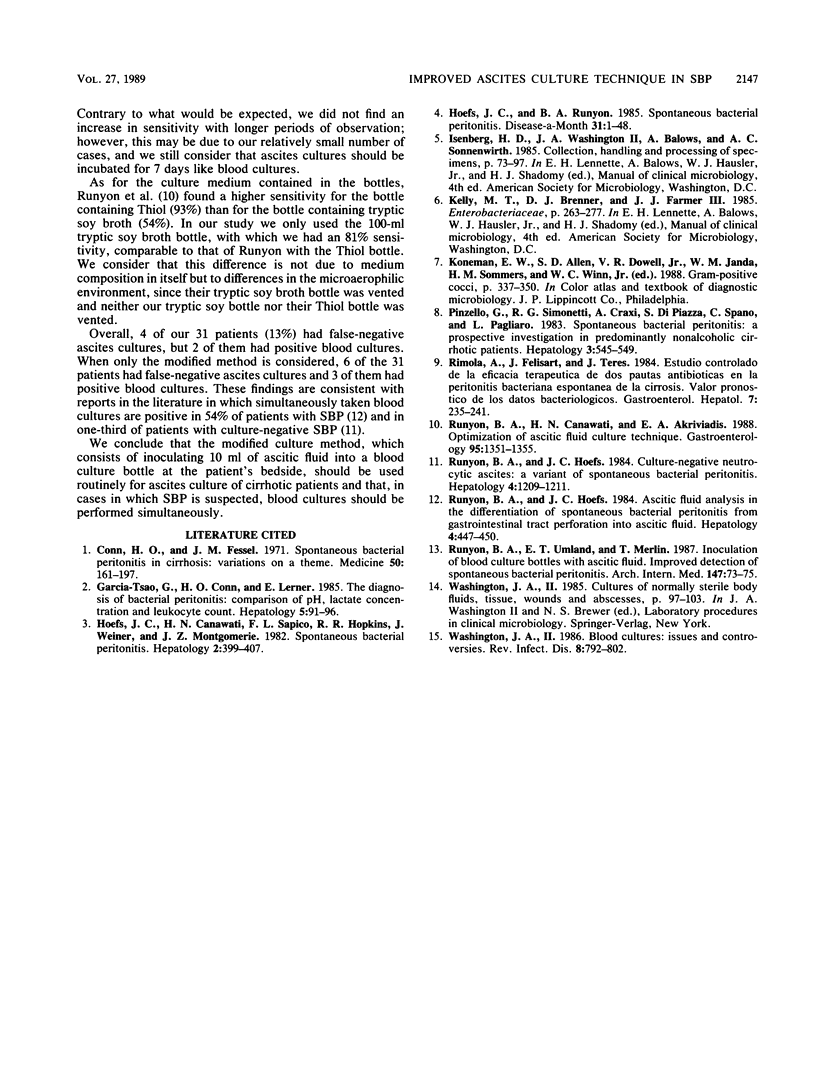Abstract
The definitive diagnosis of spontaneous bacterial peritonitis is made by a positive ascitic fluid culture. Causative organisms cannot be isolated in up to 65% of patients with well-defined spontaneous bacterial peritonitis, probably due to inadequate ascites culture techniques. We prospectively compared two ascites culture methods: conventional (on chocolate agar and thioglycolate broth) and modified (inoculation of 10 ml of ascites in a tryptic soy broth blood culture bottle at the patient's bedside). In a 10-month period, 31 cirrhotic patients met our diagnostic criteria for spontaneous bacterial peritonitis; both culture methods were performed on their ascitic fluid. The conventional method grew bacteria in only 16 of the 31 episodes (52%), whereas the modified method grew bacteria in 25 (81%), a significantly higher sensitivity (P less than 0.05). The modified method also shortened significantly the time for detection of bacterial growth. We conclude that ascites inoculation into a blood culture bottle at the patient's bedside should be the routine method for ascites culture.
Full text
PDF


Selected References
These references are in PubMed. This may not be the complete list of references from this article.
- Conn H. O., Fessel J. M. Spontaneous bacterial peritonitis in cirrhosis: variations on a theme. Medicine (Baltimore) 1971 May;50(3):161–197. doi: 10.1097/00005792-197105000-00002. [DOI] [PubMed] [Google Scholar]
- Garcia-Tsao G., Conn H. O., Lerner E. The diagnosis of bacterial peritonitis: comparison of pH, lactate concentration and leukocyte count. Hepatology. 1985 Jan-Feb;5(1):91–96. doi: 10.1002/hep.1840050119. [DOI] [PubMed] [Google Scholar]
- Hoefs J. C., Canawati H. N., Sapico F. L., Hopkins R. R., Weiner J., Montgomerie J. Z. Spontaneous bacterial peritonitis. Hepatology. 1982 Jul-Aug;2(4):399–407. doi: 10.1002/hep.1840020402. [DOI] [PubMed] [Google Scholar]
- Hoefs J. C., Runyon B. A. Spontaneous bacterial peritonitis. Dis Mon. 1985 Sep;31(9):1–48. doi: 10.1016/0011-5029(85)90002-1. [DOI] [PubMed] [Google Scholar]
- Pinzello G., Simonetti R. G., Craxì A., Di Piazza S., Spanò C., Pagliaro L. Spontaneous bacterial peritonitis: a prospective investigation in predominantly nonalcoholic cirrhotic patients. Hepatology. 1983 Jul-Aug;3(4):545–549. doi: 10.1002/hep.1840030411. [DOI] [PubMed] [Google Scholar]
- Runyon B. A., Canawati H. N., Akriviadis E. A. Optimization of ascitic fluid culture technique. Gastroenterology. 1988 Nov;95(5):1351–1355. doi: 10.1016/0016-5085(88)90372-1. [DOI] [PubMed] [Google Scholar]
- Runyon B. A., Hoefs J. C. Ascitic fluid analysis in the differentiation of spontaneous bacterial peritonitis from gastrointestinal tract perforation into ascitic fluid. Hepatology. 1984 May-Jun;4(3):447–450. doi: 10.1002/hep.1840040316. [DOI] [PubMed] [Google Scholar]
- Runyon B. A., Hoefs J. C. Culture-negative neutrocytic ascites: a variant of spontaneous bacterial peritonitis. Hepatology. 1984 Nov-Dec;4(6):1209–1211. doi: 10.1002/hep.1840040619. [DOI] [PubMed] [Google Scholar]
- Runyon B. A., Umland E. T., Merlin T. Inoculation of blood culture bottles with ascitic fluid. Improved detection of spontaneous bacterial peritonitis. Arch Intern Med. 1987 Jan;147(1):73–75. [PubMed] [Google Scholar]
- Washington J. A., 2nd, Ilstrup D. M. Blood cultures: issues and controversies. Rev Infect Dis. 1986 Sep-Oct;8(5):792–802. doi: 10.1093/clinids/8.5.792. [DOI] [PubMed] [Google Scholar]


